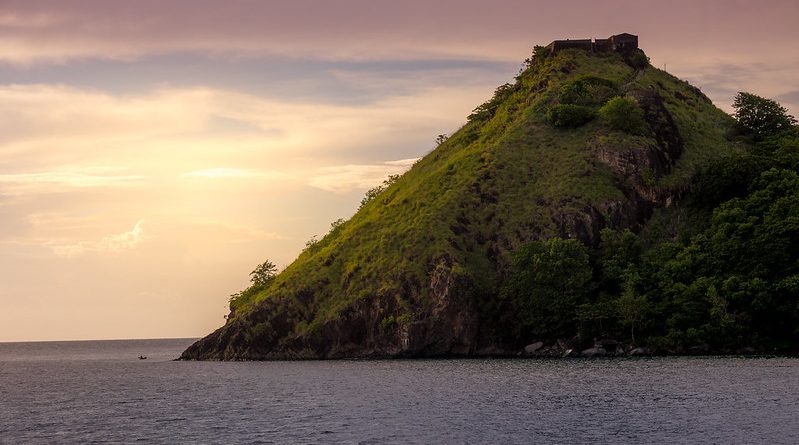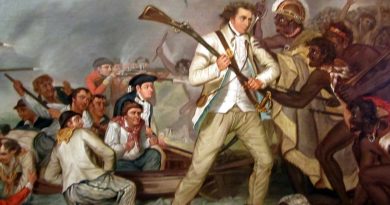Important Historical Sites of the British Empire
Fort Rodney, St. Lucia
Commissioned by its namesake Admiral George Rodney between 1779 and 1782, Fort Rodney was constructed on Pigeon Island in St. Lucia. The Fort was built as a means to spy on a nearby French naval base on the island of Martinique. Fort Rodney remained an important tactical base for the British military in the Caribbean. The Admiral had ordered all of the island’s trees to be cut down to allow a clear vantage point, which enabled the military to mount a successful attack on the French in the Battle of the Saints. Currently, the remains of Fort Rodney are situated within a 40 acre national park on the island, popular amongst hikers.
East India Company, London
An organisation synonymous with British colonial supremacy, the East India Company played a critical role in the British Empire’s dominance over the Indian subcontinent. Established in 1600, the company was indirectly controlled by the Crown and focused primarily on trade with Asian countries. Eventually, the company played an increasingly important role in the British Empire’s control and ultimate takeover of India. Its private army numbered over 250,000, considerably bigger than the British Army. Its dominance was so absolute that the Company essentially controlled and ruled over India for a century, its grip on power ended in the aftermath of the Indian Rebellion, which saw the Crown reassume control. Shortly afterwards, the Company was dissolved, essentially obsolete following its relinquishing of control of the subcontinent. Despite this, the company remains an important historical entity in regards to the British Empire and India.
Kew Gardens, London
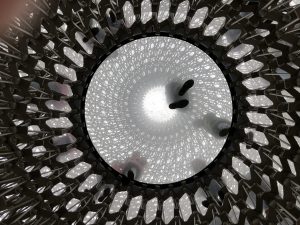 The world’s most diverse and vast botanical gardens, Kew Gardens are home to over 30,000 different plant species. In addition to its botanical significance, Kew Gardens also has a rich history stretching back centuries. The Gardens themselves were established in the 18th Century, while many of the famous buildings inside such as the Palm House and the Temperate House were built in the mid-19th Century. The Gardens became a hub for scientific research in line with the British Empire’s ascendancy to global supremacy. Expansion of the Gardens continued up until the Second World War, resuming after the conflict. In the present day, Kew Gardens is one of Britain’s most popular tourist attractions whilst still being an important outpost for scientific research.
The world’s most diverse and vast botanical gardens, Kew Gardens are home to over 30,000 different plant species. In addition to its botanical significance, Kew Gardens also has a rich history stretching back centuries. The Gardens themselves were established in the 18th Century, while many of the famous buildings inside such as the Palm House and the Temperate House were built in the mid-19th Century. The Gardens became a hub for scientific research in line with the British Empire’s ascendancy to global supremacy. Expansion of the Gardens continued up until the Second World War, resuming after the conflict. In the present day, Kew Gardens is one of Britain’s most popular tourist attractions whilst still being an important outpost for scientific research.
HMS Victory, Portsmouth
One of the world’s most famous and historically significant naval vessels, the HMS Victory is one of the defining symbols of the British Empire’s military power. Ordered and laid down in 1758-9, the HMS Victory is a 104-gun first-rate ship, which played a pivotal role in the famous Battle of Trafalgar in 1805 as the campaign leader Lord Nelson’s flagship. Despite sustaining damage during the conflict, the HMS Victory survived, although it was never utilised again in a military battle. The vessel was briefly used as a prison ship and a floating depot, relegated to the role of a harbour ship in 1824. Nearly 100 years later in 1922, the HMS Victory moved to a dry dock in Portsmouth, renovated and preserved as a museum ship. It remains a popular tourist attraction and one of the British Empire’s most enduring physical relics.
Port Arthur, Australia
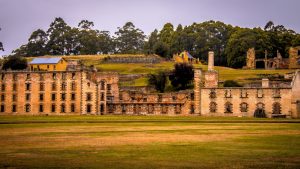 Situated on the Australian island of Tasmania, Port Arthur is one of the country’s most significant historical sites due to its past as a convict settlement in the early years of the British control over the continent. Port Arthur forms a part of the Australian Convict Sites, a collection of World Heritage sites dedicated to providing a clear view of the British Empire’s penal system on the colony. Port Arthur, as the island’s top tourist attraction, is considered to be the most important of these, providing visitors with an insight into early colonial life in Australia. Many of the structures remain intact and well-preserved.
Situated on the Australian island of Tasmania, Port Arthur is one of the country’s most significant historical sites due to its past as a convict settlement in the early years of the British control over the continent. Port Arthur forms a part of the Australian Convict Sites, a collection of World Heritage sites dedicated to providing a clear view of the British Empire’s penal system on the colony. Port Arthur, as the island’s top tourist attraction, is considered to be the most important of these, providing visitors with an insight into early colonial life in Australia. Many of the structures remain intact and well-preserved.
Albertopolis, London
One of the British capital’s most important educational and cultural hubs, Albertopolis is the informal name given to the area centred around Exhibition Road, near Hyde Park. Prominent sites include Imperial College London, the Victoria & Albert Museum, the National History Museum and the Royal Albert Hall, amongst others. Named for Prince Albert, the spouse of Queen Victoria, the area boasts several of Victorian architecture’s most significant accomplishments. Albertopolis is one of the capital’s most important areas, both as a historical document and an intellectual centre.
Bombay Railway Station, Mumbai
Now known as the Chhatrapati Shivaji Maharaj Terminus, this is one of the British Empire’s most significant relics in India. Designed by architect Frederick William Stevens, the Terminus is an important piece of Victorian Gothic architecture. Constructed in 1887 as a commemoration of Queen Victoria’s Golden Jubilee, the terminus is a grandiose symbol of Colonial India as well as the Victorian era. The railway station is currently the administrative centre of the Central Railways and remains one of the country’s busiest well over a century after its construction.
Raffles Hotel, Singapore
Named after British colonialist and the ‘founder’ of Modern Singapore Sir Thomas Stamford Raffles, this hotel is one of Singapore’s most iconic sites. Well-known for its colonial design, the hotel was opened in 1887 by an Armenian hotelier family. Now a national institution of Singapore, the hotel is more of a tribute to the colonial period rather than an authentic relic of it. The hotel remains a popular tourist attraction in the country today, functioning as a hotel and as a museum, which offers a window into colonial life in Singapore.
Singapore Botanical Gardens, Singapore
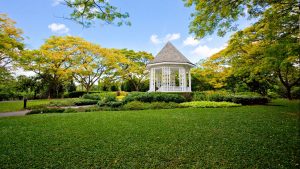 One of Singapore’s most popular tourist sites with over 4 million annual visitors, the Botanical Gardens are amongst the most spectacular on the planet. Established in 1859, the Gardens are historically important as being the source of the region’s major rubber trade boom, as the main centre for research into the material’s cultivation. Through this research, the area held a monopoly on latex production for decades.
One of Singapore’s most popular tourist sites with over 4 million annual visitors, the Botanical Gardens are amongst the most spectacular on the planet. Established in 1859, the Gardens are historically important as being the source of the region’s major rubber trade boom, as the main centre for research into the material’s cultivation. Through this research, the area held a monopoly on latex production for decades.
Viceroys House, Delhi
Now known as the Rashtrapati Bhavan, this is currently the official residence of the Indian President, but as indicated by its former name, was an important colonial site in India. Designed by prominent architect Edwin Landseer Lutyens, the building initially served as the residence for the British Viceroy in the then-new capital of Delhi. The building is known for its complex, unique design, which drew from a variety of different architectural influences. Built during the Edwardian Baroque Period, the House drew from Classical styles, as well as more contemporary colonial and Mughal influences. The adjacent Mughal gardens are a testament to the diverse design.

